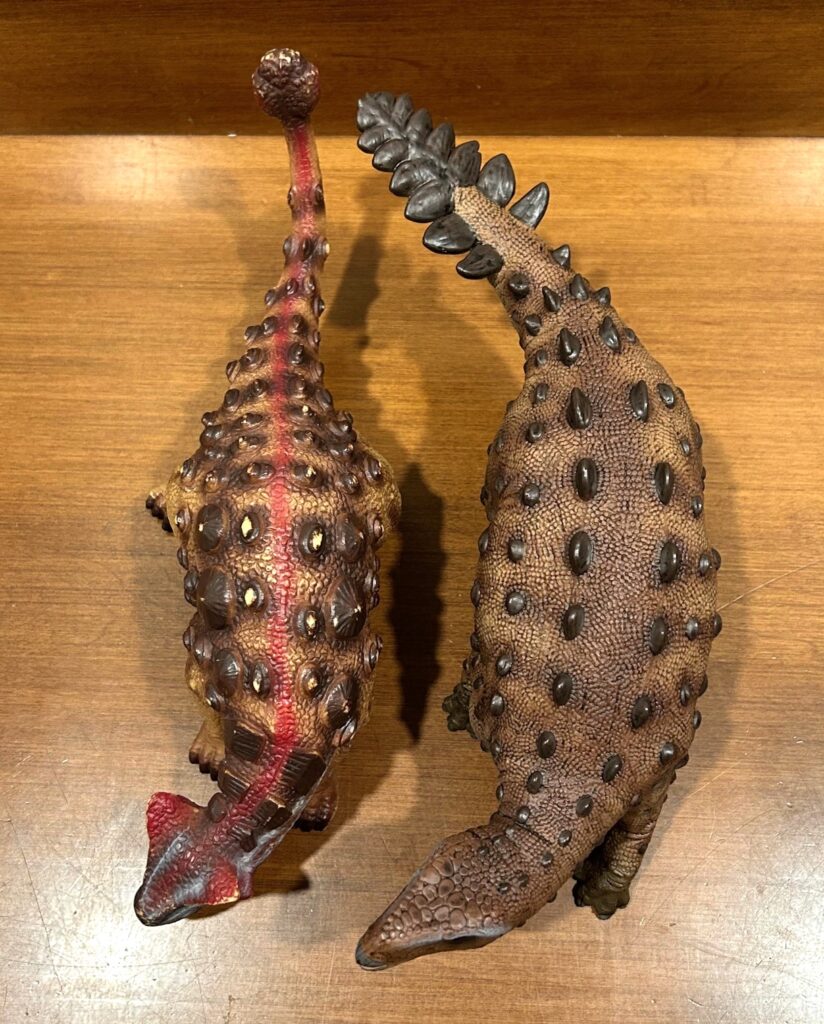
Most ankylosaurs are classified as either Ankylosauridae or Nodosauridae. Ankylosaurids are easily distinguishable by their wide, blocky heads and tails terminating in solid bone clubs, and include the likes of Ankylosaurus itself, Euoplocephalus, Jinyunpelta, Pinacosaurus, and Zuul. By contrast, nodosaurids like Animantarx, Borealopelta, Edmontonia, Gastonia, and Sauropelta are distinguished by their narrower, more triangular heads and clubless tails. But there’s also a third family, Parankylosauria. They lived in Gondwana during the Cretaceous period and they were much smaller and more basal than the ankylosaurids and nodosaurids. Examples include Antarctopelta from Antarctica, Kunbarrasaurus from Australia, and the subject of this review, Stegouros from Chile.


Discovered in 2018 and formally named and described in 2021, Stegouros elengassen was only around two metres in length at most and roughly the size of a domestic dog, making it one of the smallest ankylosaurs known. CollectA’s 2023 Deluxe Stegouros, however, is quite the gargantuan toy, measuring slightly over 24 cm long, 9 cm tall at the hips, and 7 cm wide. This makes it their biggest ankylosaur toy to date, even bigger than the Deluxe Ankylosaurus as shown below. Some collectors may be put off by its great size, but personally, scale has never been that much of an issue for me. Also, I think it’s kind of funny how it dwarfs every other ankylosaur in my collection when it was quite the opposite in reality.


The main colour on this toy is medium brown with dark wash, dull sandy yellow for the underbelly, dark brown for the osteoderms and spikes, dark grey for the claws and beak, a dull pink tongue, and pinkish grey streaks over the glossy black eyes. Overall, it’s pretty standard coloration for an ankylosaur toy, nothing out of the ordinary, but as always, it looks perfectly plausible.

The Stegouros is posed with its front limbs bent and its feet firmly planted. Both the head and the tail are raised and turning to the right, and the mouth is wide open. Presumably it is either attempting to ward off a predator or engaging in combat with another of its kind. Again, quite a few other ankylosaur toys are posed similar to like this, but it always does work for them. Between its pose and its size, this armoured beast looks quite formidable indeed.


In addition to being one of the smallest known ankylosaurs, Stegouros is notable for a number of anatomical features which are well reflected on this toy. The head is relatively elongated, V-shaped when viewed from above, and very big, proportionally bigger than those of most other ankylosaurs. There are no scutes projecting from the back of the head, but there are large, flattened scales that probably would have afforded it some decent protection.


The entire body is covered in fine pebbled scales and as usual, there are heavy wrinkles around the limb joints and hanging down from the neck and flanks. The limbs are fairly long, indicating that Stegouros could have tried to flee from large predators as an alternative to as standing and fighting. The hind feet have three large toes and one tiny inner toe, all with claws, while the front feet have five toes with claws on all but the outermost. Multiple rows of keeled osteoderms run down the neck, back, and tail, and on the limbs as well. The armour overall more closely resembles an ankylosaurid’s than a nodosaurid’s. All in keeping with the known fossil material, which, happily, is nearly complete.

And that brings us at last to the Stegouros‘ tail. Instead of a rounded club or no weapon at all, the tip has seven pairs of large, flattened osteoderms that are merged together to form a most unique structure. The shape strongly resembles either the profile of a pinecone or an ancient Aztec macuahuitl, which is a wooden club equipped with sharpened shards of obsidian along the outer edge. Antarctopelta may have possessed a similar tail as well. Indeterminate theropod remains have been recovered from the Dorotea Formation where Stegouros was found, so it probably had need for a good defensive weapon. Its primary purpose, though, was likely intraspecific conflict. In any case, a blow from that tail would undoubtedly have been painful. And can you imagine if this animal was the same size as Ankylosaurus? Yikes!

While the size of the CollectA Stegouros may admittedly be off-putting to some collectors, I consider it to be an absolute must-have. It’s superbly sculpted, scientifically accurate, it looks great with the other ankylosaurs on my shelf, and it’s a welcome bit of variety. CollectA may wish to consider following up on this beauty by releasing a Kunbarrasaurus in the future, as it’s presently the only other parankylosaur known from ample fossil remains. My heartiest thanks go out to them for this review sample! 🙂

Support the Dinosaur Toy Blog by making dino-purchases through these links to Ebay and Amazon. Disclaimer: links to Ebay.com and Amazon.com on the The Dinosaur Toy Blog are often affiliate links, when you make purchases through these links we may make a commission
Trending Products











